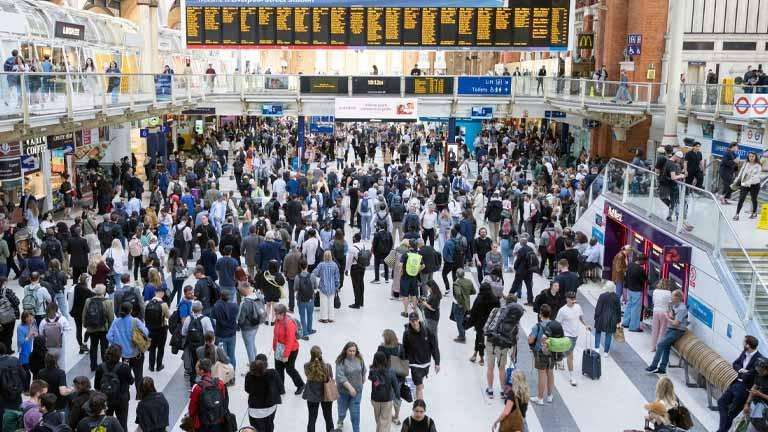The number of rail passengers travelling into cities in England and Wales has overtaken pre-Covid levels but changing work and travel patterns have eased overcrowding on the morning commute, official statistics show.
Almost 1.9 million people took trains into cities on a typical weekday last autumn, the highest figure since the records were first collated in 2010.
However, there were still about 13% fewer passengers arriving during the morning peak than in 2019, showing that the return to traditional nine-to-five office working remains some way off, despite recent pressure on staff from some firms.
Arrivals into every station in London grew in the 12 months to autumn 2024, with particularly rapid growth at Paddington and Liverpool Street stations, both served by the Elizabeth line. The data suggests that the line, fully opened in 2023, has taken the pressure off other trains, with overcrowding in the capital down from 2019 levels.
Now busier trains into Birmingham are matching London for the squeeze on commuters, according to the Department for Transport. Five Thameslink and West Midland services were the most overcrowded, with the 7.30am Bedford to Three Bridges having an 184% load factor – or almost twice as many passengers as seats – when it reached London St Pancras.
Southwestern and Chiltern services made up the rest of the top 10 most overcrowded trains recorded by the DfT.
The total number of people travelling into cities outside London remains below pre-pandemic levels, at about 660,000 daily arrivals compared with 730,000 in 2019.
The DfT figures allow for standing capacity on many London commuter services, with almost one in four passengers standing on arrival in the morning.
It found that average overcrowding – or “passengers in excess of capacity” – on midweek (Tuesday to Thursday) morning arrivals to the capital had increased slightly in the last 12 months to 1.6%, a figure now matched by Birmingham, with trains arriving at Bristol and Sheffield stations ranking as the next most crowded, after rapid growth in rail commuting last year.
The DfT said that while directly equivalent statistics on crowding were not available, British rail passenger numbers appeared to be recovering faster than those in France, Germany or Italy, with growth of 9% last year compared with 5-7% in the three biggest EU economies.
Public transport campaigners heralded the figures as underlining the return of rail, after passenger numbers dropped to as little as 5% of pre-pandemic levels in 2020, followed by pay freezes and industrial unrest.
Ben Plowden, of the Campaign for Better Transport, said: “Gloomy predictions for the future of rail at the time of the pandemic have proven wrong: rail is back in a big way, boosting our economy, keeping workers moving and saving our streets from gridlock.
“The fact that passenger arrivals are up while overcrowding is down is partly due to the huge success of the Elizabeth line. With more bold projects like this we could transform cities and improve daily life for vast numbers of people. An expanded rail network combined with more affordable fares could really bring about a rail revolution.”
Rail fares are expected to continue to rise above inflation, however, as revenue is still significantly lower than before the pandemic, with more people travelling off-peak.
The report noted that Southwestern, once the railway’s most lucrative commuter network, had roughly two-thirds of its previous demand, now concentrated from Tuesday to Thursday.
A number of businesses in the City, including banks and hedge funds, have been pushing staff to return full-time to the office in recent months. However, recruitment firms say workers fear the impact on their wellbeing, as well as the cost of commuting. Hybrid working is now the standard mode for more than a quarter (28%) of working adults in the UK, according to the Office for National Statistics.



_2.jpg)
_3.jpg)



.svg)

.jpg)
